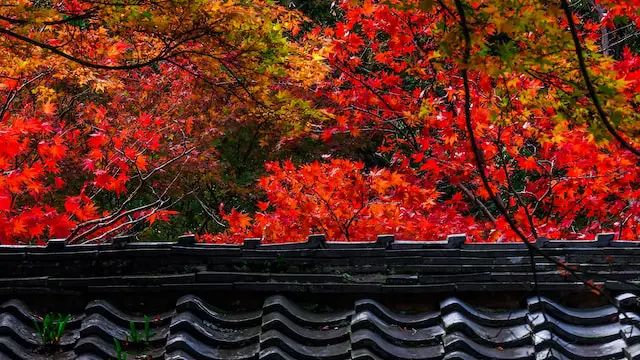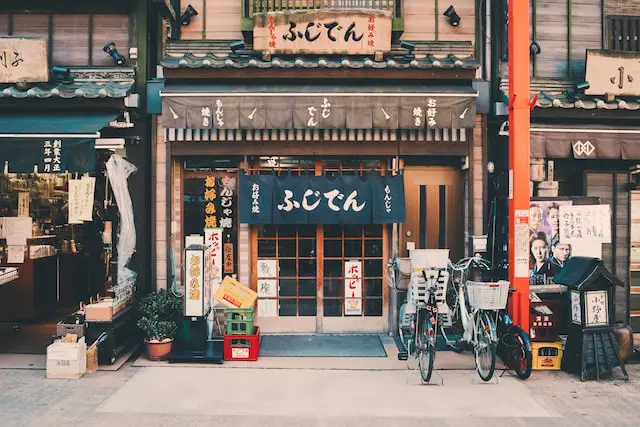Welcome to the unique venture of exploring Japan through the lens of one of its most iconic literary forms: Haiku poetry.
Visualize a journey, not just across the map, but traversing through cultural transcripts, tied together by deeply rooted traditions. You delve into landscapes that have inspired centuries of succinct, evocative poetry. This isn’t merely Japan travel, it’s a cultural journey that echos with the rhythm of Haiku, each syllable an invitation to look deeper and appreciate more.
How does the concept of harmony pervade everyday things? How does it find a voice in Japan’s literature, its culture, and ultimately in its ubiquitous Haiku poetry? Offering a subjective sensory feast, this trip will answer these questions, and more.
Stay tuned, as we unfold the picturesque realm where nature, culture, history and literature converge to give you the ultimate Japanese experience.
The History and Influence of Haiku in Japanese Literature
When you embark on the journey of understanding the depth of Japanese culture, plunging into the heart of its literature becomes inevitable. One of the most remarkable and internationally revered forms of this literature is Haiku poetry.
Haiku emerged from a type of collaborative linked verse called renga during the 16th century. Its humble beginnings were markedly transformed when poet Matsuo Basho, often revered as the “father of Haiku”, began writing in the 17th century. His reflective and profound verses set the standard for this minimalist aesthetic that the Japanese and subsequently the world came to love.
The haiku, with its strict 5-7-5 syllable pattern, quickly became not just a poetic form but a profound cultural symbol. It influenced how the Japanese expressed their thoughts, emotions, and observed their environment. Tokugawa-era society was mesmerized by the layered simplicity of Haiku and it became a popular activity in court circles, sweeping through all classes of society, leaving an immeasurable impact on Japanese literature.
Today, Haiku’s influence extends beyond the realm of literature. It embodies the essence of Japan’s zeitgeist: the intricate balance of nature and self-awareness, simplicity infused with depth, and the transient beauty of the moment captured in words. It continues to inspire and resonate, becoming a uniquely Japanese lens through which to view and experience the world.
Cultural Significance of Harmony in Japan
There’s no conversation about Japanese culture that can be complete without mentioning the imperative role of harmony. Known as wa in Japanese, harmony is woven into the very fabric of the nation’s daily living, traditions, and of course, its literature.
Understanding this fundamental aspect of Japanese culture will often reveal new layers of meaning in the country’s famous Haiku poetry. The dense, yet delicate ecosystems of syllables in each Haiku invariably reflect this sophisticated balance. They resonate with the principles of yōgen (mystery) and yūgen (depth and subtlety), painting vivid pictures of life, love, nature, and transcendence with simplicity and grace.
Step into Japan and you’ll find harmony a recurring theme – in the meticulously styled rock gardens of Kyoto, to the minimalist aesthetics of a traditional tea ceremony, and the peaceful co-existence of modern skyscrapers existing alongside centuries-old shrines in bustling Tokyo.
Haiku poetry magnifies this sense of harmony. An entirely unique form of expression, Haiku encapsulates and distills Japan’s seasons, landscapes, and way of life, poignantly into seventeen syllables. This art form is imbued with ma or negative space, which advocatess for silence and emptiness, allowing the audience to embrace the unsaid and the subtle.
In essence, to truly understand and appreciate Haiku, one must value the delicate dance of harmony — the balance of human life entwined with nature, a sentiment deeply rooted in Japan’s cultural psyche.
Exploring Japan’s Literary Landscape through Haiku
In journeying through the breathtaking, rich, and diverse landscapes of Japan, it’s impossible to disconnect from the mystical and profound realm of Haiku. This cherished form of poetry cast in 17 syllables has shaped and been shaped by the heartbeat of the land.
The Arashiyama Bamboo Grove in Kyoto extends an otherworldly invitation into the realm of green. Towering bamboo stalks sway in melodious harmony, rustling gently with the wind – a scene so poetic it echoes in verses of many renowned Haikus. Its surreal beauty often linked with a sense of solitude and peace, inherent to Haiku poetry.
Moving onto the antiquity-laden Samurai district in Kanazawa, the stone-paved streets and well-preserved traditional houses are symbols of an era forever captured in Haiku. This enclave of culture and history reverberates a unique blend of elegance and restraint, staple elements of Haiku.
Lastly, the serenely snowy landscapes of Hokkaido are a recurring backdrop in Haiku verses. The pure winter fields, solemn tranquility, and the stark beauty of nature in its hibernation frequently resonate in the syllables of Haiku, painting a pristine image of life’s transient nature.
These iconic locations represent the undisclosed foray into Japan’s literary landscape through Haiku. Each destination not merely a point on a map, but pages in a living anthology that continues to inspire the creation of this riveting form of poetry.
Whether it’s the calming rustle of the Arashiyama grove or the silent grace of Hokkaido’s snowy fields, the true essence of these places is best captured and remembered through the lens of Haiku.
Visiting Japan’s Contemporary Haiku Literary Scene
Japan’s engaging modern Haiku scene is teeming with vibrancy and life! This centuries-old literary form continues to thrive within its unique contemporary context. As part of your wholesome Japan travel experience, make sure to delve into the world of Contemporary Haiku, which effortlessly marries tradition with innovation.
A splendid place to kickstart your poetic journey would be the famous libraries in Tokyo, notably the Shiki Memorial Museum, where you’ll explore the depth and richness of Japanese poetry events and history. These spaces not only offer a wealth of knowledge but importantly, host regular exhibitions, workshops, and performances dedicated to Haiku. Visitors have unique opportunities to engage with, and even contribute to this dynamic art form.
The Tokyo travel itinerary wouldn’t be complete without attending the annual Japan Haiku Association Conference. This event showcases the best of modern Haiku, attracting poets and enthusiasts from across the globe. It’s a melting pot of creativity, where one can witness how Haiku continues to transcend cultural borders, earning global admiration and respect.
Traveling to Japan and exploring its contemporary Haiku scene provides a nuanced lens to appreciate the country’s breathtaking beauty. It is a chance to walk side-by-side with poets, relishing in the shared love for the succinct and the profound. Whether you’re a seasoned Haiku aficionado or a curious traveler seeking a deeper cultural journey, visiting Japan’s modern Haiku hubs is a richly rewarding experience.
The Intersection of Harmony and Haiku in Japanese Places
Japan’s cultural tapestry is strung together with threads of harmony, making each destination a source of tranquility and peace. These unique aspects of the Japanese lifestyle are often reflected in Haiku, a form of poetic exploration deeply rooted in the embrace of the country’s natural beauty.
A visit to the serene landscape of Arashiyama, for instance, is an encounter with the quintessence of harmony as depicted in various Haiku. The whisper of the wind sifting through the Bamboo Grove, encapsulated in haikus, communicates an atmosphere of tranquil coexistence. One can easily sense the rhythm of nature here, like the gentle sway of the bamboo trees aligning with the tune of the wind.
Similarly, the Samurai district of Kanazawa is yet another example of life-poetry balance. The historical streets and traditional architecture whisper stories of their past, provoking an introspective mood that has inspired numerous Haiku. It’s impossible not to sit back, brush in hand, and allow your thoughts to form their own 17-syllable journey.
Hokkaido’s snowy landscapes, which paint a picture of stillness and serenity, are also featured in many Haikus. They evoke an overwhelming sense of silence and solitude, forcing one to connect with their inner zen. The vast skies, the endless white fields, every sound muffled by the snow– it’s a perfect Haiku scene, yearning to be captured.
In conclusion, each Japanese locale breathes life into Haiku, illustrating the presence of harmony and its profound impact on the country’s cultural psyche. Indeed, traveling through Japan enables a unique understanding of this delicate balance.
How to Experience and Create Haiku in Japan
Discovering the poetic heart of Japan doesn’t just come from reading Haiku, but also from embodying its spirit and crafting your masterpiece. Savoring these distilled moments of beauty, encapsulated in prominent Japanese literature forms, enhances your cultural journey in this exquisite country.
Begin by tuning in with the subtle cues of nature, and the understated elegance of Japanese urban and rural scapes. Visit parks and historic sites, like the tranquil Zen gardens or vibrant markets, and let your senses absorb the rhythm and pulse of the Japanese lifestyle.
Take plenty of time to reflect on the harmony you’ve observed, perhaps while savoring a bowl of matcha in a traditional tea house. This feeds the essence of interactive travel as it gives you first-hand materials to work on. Let your pen mode the vibes you’ve volumed into a season-specific, 5-7-5 syllable verse – your very own Haiku.
Consider joining poetry writing workshops, offered in various cities across Japan. You’ll not only learn about the structural and aesthetic constraints of Haiku but also gain fascinating insights into the philosophy behind this literary form. Local poets often facilitate these sessions, providing you with unique insights into the culture and mindset of Haiku creation.
Whether it’s your first or hundredth time to explore Japan travel, Haiku adds a beautiful dimension to your experiences. So, dive deeper into Japan’s soul, one Haiku at a time.
Conclusion
As we draw our journey to a close, we’re left with a stunning tapestry of impressions and realizations about Japan’s rich literary landscapes. Our exploration has led us through verdant bamboo groves of Arashiyama and the timeless beauty of the Samurai district in Kanazawa, all the way up to the ice-kissed landscapes of Hokkaido. These places not only reflect scenic beauty but also the inherent harmony that is so deeply rooted in Japanese culture.
Through the lens of Haiku, a world-renowned form of Japanese poetry, we’ve been given a unique glimpse into the soul of Japan. These concise lines of verse capture the essence of a moment, invariably reflecting the Japanese emphasis on harmony with nature, encapsulating experiences that are at once profoundly individual and universally evocative.
This journey beyond the realms of ordinary travel, a cultural immersion, heightened by the ethereal world of haiku, does much more than merely showcase Japan’s picturesque landscapes. It’s an invitation to delve deeper, to look beyond the surface, to perceive the extraordinary in the ordinary, to capture the fleeting beauty of a moment through the language of Haiku.
A visit to Japan hence becomes a poetic pilgrimage, offering a rare chance to experience Haiku in its natural habitat and even try one’s hand at creating these succinct poems. Equipped with this new lens, one is bound to discover a deeper, more nuanced understanding of Japanese culture, making your Japan experience significantly more enriching.
All told, Japan is not just a country—it’s a cultural and poetic journey, one that leaves one not just charged with memories, but profoundly changed.




